Research on Shape Control Characteristics of Non-oriented Silicon Steel for UCMW Cold Rolling Mill
Abstract
1. Introduction
2. Establishment of Finite Element Model of UCMW Cold Rolling Mill Roll System
2.1. Rolling Mill Parameters and Model Establishment
- (1)
- Ignore the effects of the strip tension and the rolling torque.
- (2)
- The material of the roll is uniform and isotropic.
- (3)
- The axis of the roll is coplanar, which is symmetrical.
- (4)
- There is no relative sliding between the rollers.
- (5)
- The influence of rolling temperature is not considered, namely, ignore the influence of thermal crown.
- (6)
- Only the deformation of the roll system below the rolling line is calculated, and the interaction of the strip and the roll system is reflected by the uniformly distributed pressure.
2.2. Field Data Acquisition and Simulation Condition Design
3. Experimental Verification of the Model
4. Analysis of Shape Control Characteristics for UCMW Cold Rolling Mill
4.1. Effect of Unit Width Rolling Force on Roll Gap Shape
4.2. Effect of Intermediate Roll Bending Force on Roll Gap Shape
4.3. Effect of Work Roll Bending Force on Roll Gap Shape
4.4. Effect of Intermediate Roll Shift on Roll Gap Shape
4.5. Effect of Work Roll Shift on Roll Gap Shape
5. Conclusions
Author Contributions
Funding
Acknowledgments
Conflicts of Interest
References
- Peng, Y.; Liu, H.M.; Wang, D.C. Simulation of type selection for 6-high cold tandem mill based on shape control ability. J. Cent. South Univ. Technol. 2007, 14, 278–284. [Google Scholar] [CrossRef]
- Zhou, X.M.; Cheng, X.X. The Analysis of Influence on the Edge Drop of Tandem Cold Rolling Mill. Appl. Mech. Mater. 2014, 3147, 363–366. [Google Scholar] [CrossRef]
- Wang, L.B.; Yan, L.J.; He, A.R. Research and Optimization for Transverse Thickness Difference Control Strategy of UCMW Cold Tandem Mill. Adv. Mater. Res. 2013, 2300, 1520–1524. [Google Scholar] [CrossRef]
- Zhang, Q.D.; Chen, X.L. New Six-High Mills in Cold Tandem Rolling - Control Strategies and Performance Characteristics. Adv. Mater. Res. 2012, 1992, 1–6. [Google Scholar] [CrossRef]
- Du, X.Z.; Yang, Q.; Huang, Q.X. Equation of Shape Control and Edge Drop on UCMW Tandem Cold Mill. Adv. Mater. Res. 2012, 1992, 94–97. [Google Scholar] [CrossRef]
- Zhang, Y.; Yang, Q.; Shao, J. Effect of the end shape of tapered work roll on edge drop of cold rolled strip. In Proceedings of the Third International Conference on Mechanical Engineering and Mechanics, Beijing, China, 21 October 2009; pp. 1411–1416. [Google Scholar]
- Laurent, V.D.R.; Jean, J.C.; Stephane, T. New on-line gage for edge drop measurement and effect of tapered work rolls. Iron Steel Eng. 1995, 72, 27–32. [Google Scholar]
- Abdulrahman, A.; Zheng, Y.J.; Dong, B.W. Thin Strip Profile Control Capability of Roll Crossing and Shifting in Cold Rolling Mill. Mater. Sci. Forum. 2014, 2823, 70–78. [Google Scholar]
- Nakhoul, R.; Montmitonnet, P.; Legrand, N. Manifested flatness defect prediction in cold rolling of thin strips. Int. J. Mater. Form. Off. J. Eur. Sci. Assoc. Mater. Form. ESAFORM 2015, 8, 283–292. [Google Scholar] [CrossRef]
- Wang, L.B.; Yan, L.J.; He, A.R. Research on Broken Edge Wave Control Strategy Caused by Edge Drop Control in UCMW Cold Tandem Rolling. Adv. Mater. Res. 2013, 2300, 1525–1529. [Google Scholar] [CrossRef]
- Wang, X.C.; Yang, Q. Research on Asymmetric Shape Control Character and Generalized Overall Shape Control Strategy for Universal Crown Mill. J. Mech. Eng. 2012, 48, 58–65. [Google Scholar] [CrossRef]
- Wehr, M.; Abel, D.; Lohmar, J. Improving the thickness accuracy of cold rolled narrow strip by piezoelectric roll gap control at high rolling speed. CIRP Ann. 2018, 67, 313–316. [Google Scholar]
- Zhang, Q.D.; Wang, W.G.; Wu, Y. Coordinated control of steel strip shape and surface roughness of cold-rolled strip. Chin. J. Eng. 2005, 27, 232–234. [Google Scholar]
- Yan, Q.T.; Zhang, J.; Jia, S.H. Research on Analyzing the Flatness Adjusting Capacity for Cold Mill and Its Application. J. Mech. Eng. 2011, 47, 77–81. [Google Scholar] [CrossRef]
- Han, Z.D.; Liu, X.B.; Yuan, G.Q. Influence Factor Analysis of Loaded Roll Gap Crown with Copper Strip Rolling. Mach. Des. Manuf. 2019, 3, 234–237, 241. [Google Scholar]
- Feng, X.W.; Wang, X.C.; Yang, Q. Analysis of Edge Drop Control Performance of Work Roll Contour on Six-high Cold Rolling Mill. J. Mech. Eng. 2019, 55, 83–90. [Google Scholar] [CrossRef]
- Cao, J.G.; Jiang, J.; Qiu, L. High precision integrated profile and flatness control for new-generation high-tech wide strip cold rolling mills. J. Cent. South Univ. (Med. Sci.) 2019, 50, 1584–1591. [Google Scholar]
- He, A.R.; Shao, J.; Sun, Q. Transverse Thickness Deviation Control of Non-oriented Silicon Steel during Cold Rolling. J. Mech. Eng. 2011, 47, 25–30. [Google Scholar] [CrossRef]
- Cao, J.G.; Zhang, Y.; Yang, G.H. Intermediate roll contour of 6-hi UCM cold rolling mill. J. Cent. South Univ. (Med. Sci.) 2011, 42, 966–971. [Google Scholar]
- Zhou, X.M.; Zhang, Q.D.; Wang, C.S. Analysis of Edge Drop Control Performance and Influencing Factors of UCMW Rolling Mill. Chin. J. Eng. 2007, 29, 417–420. [Google Scholar]
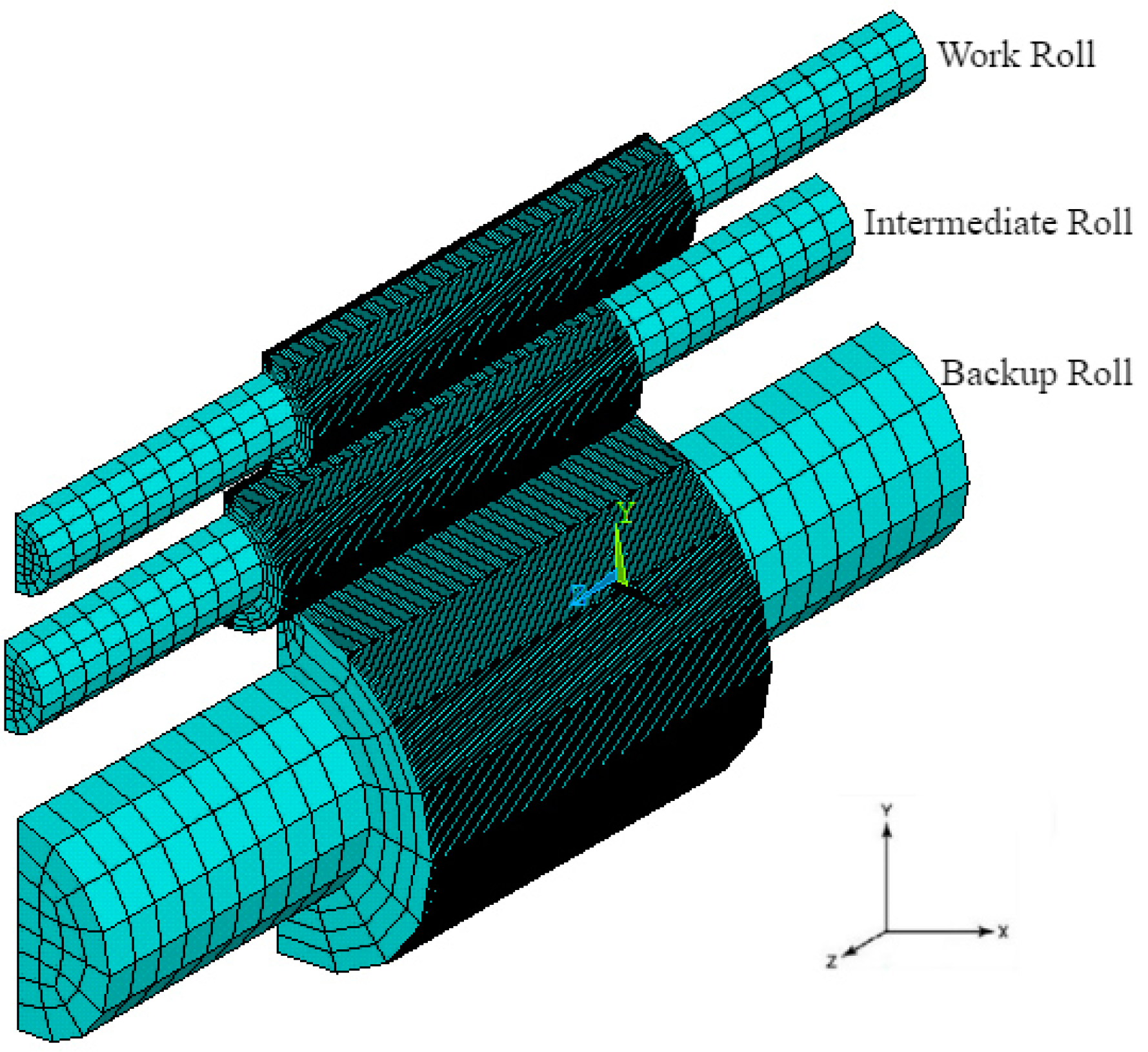

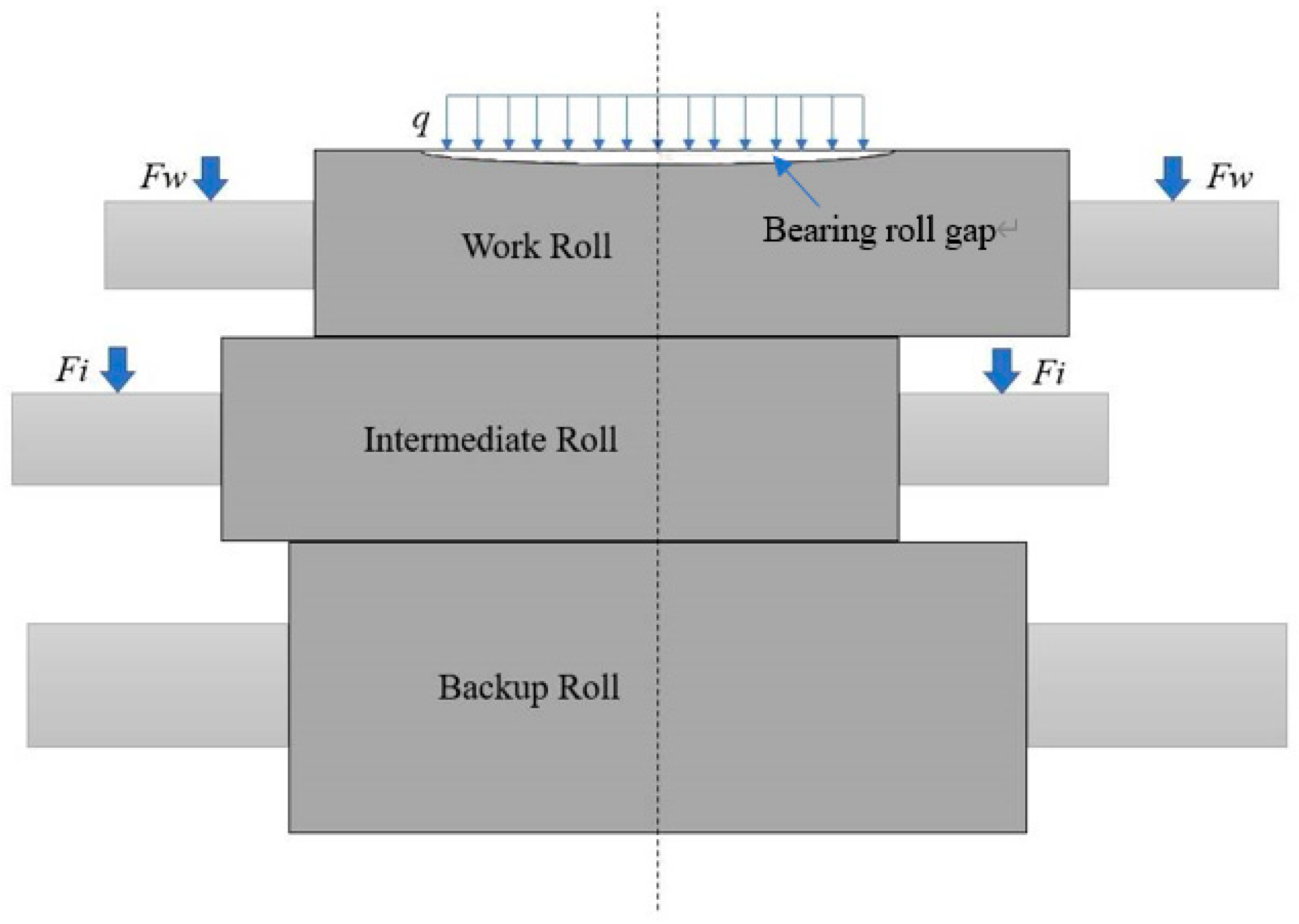
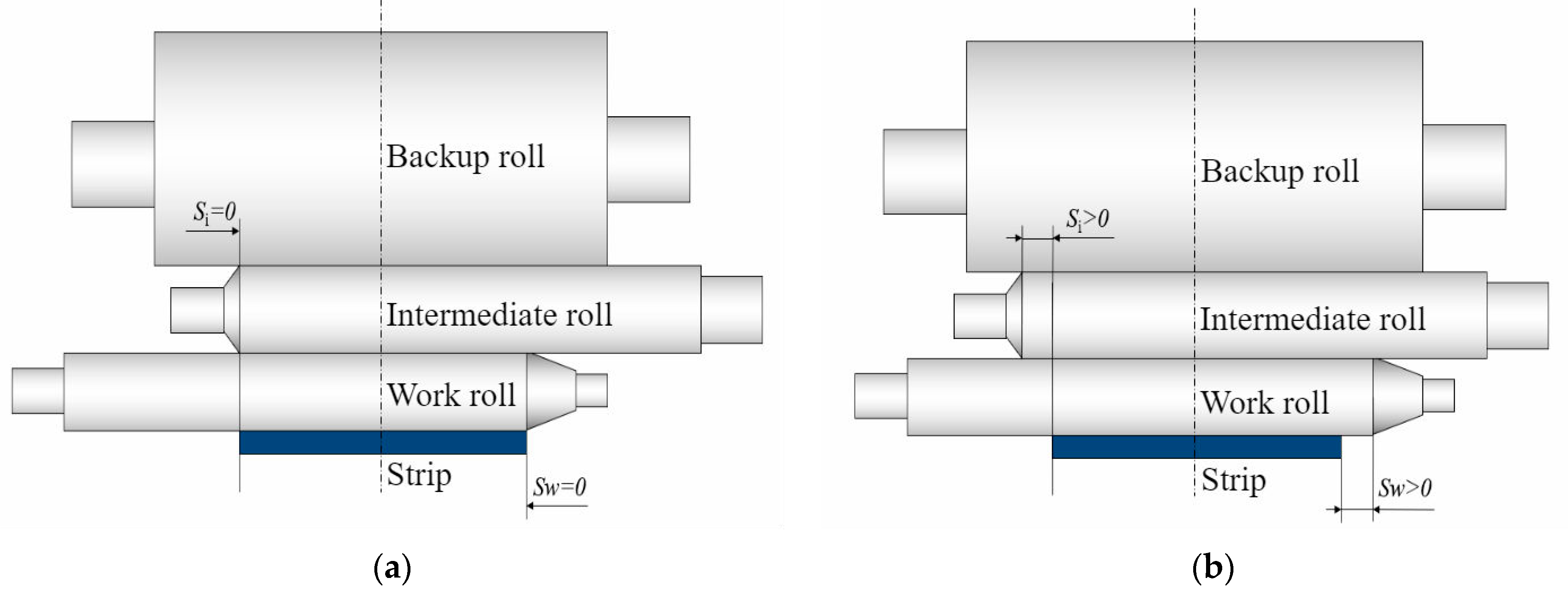
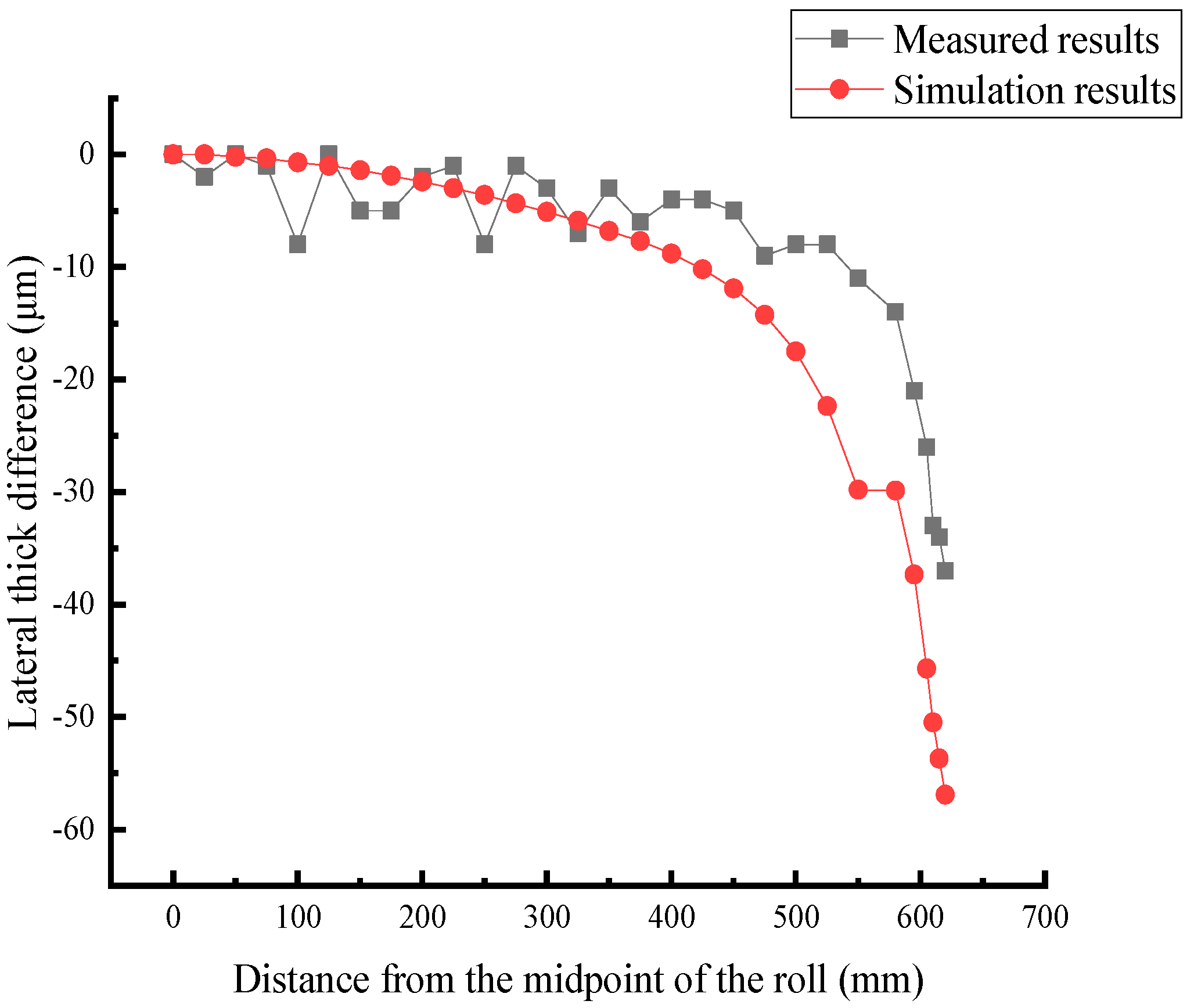



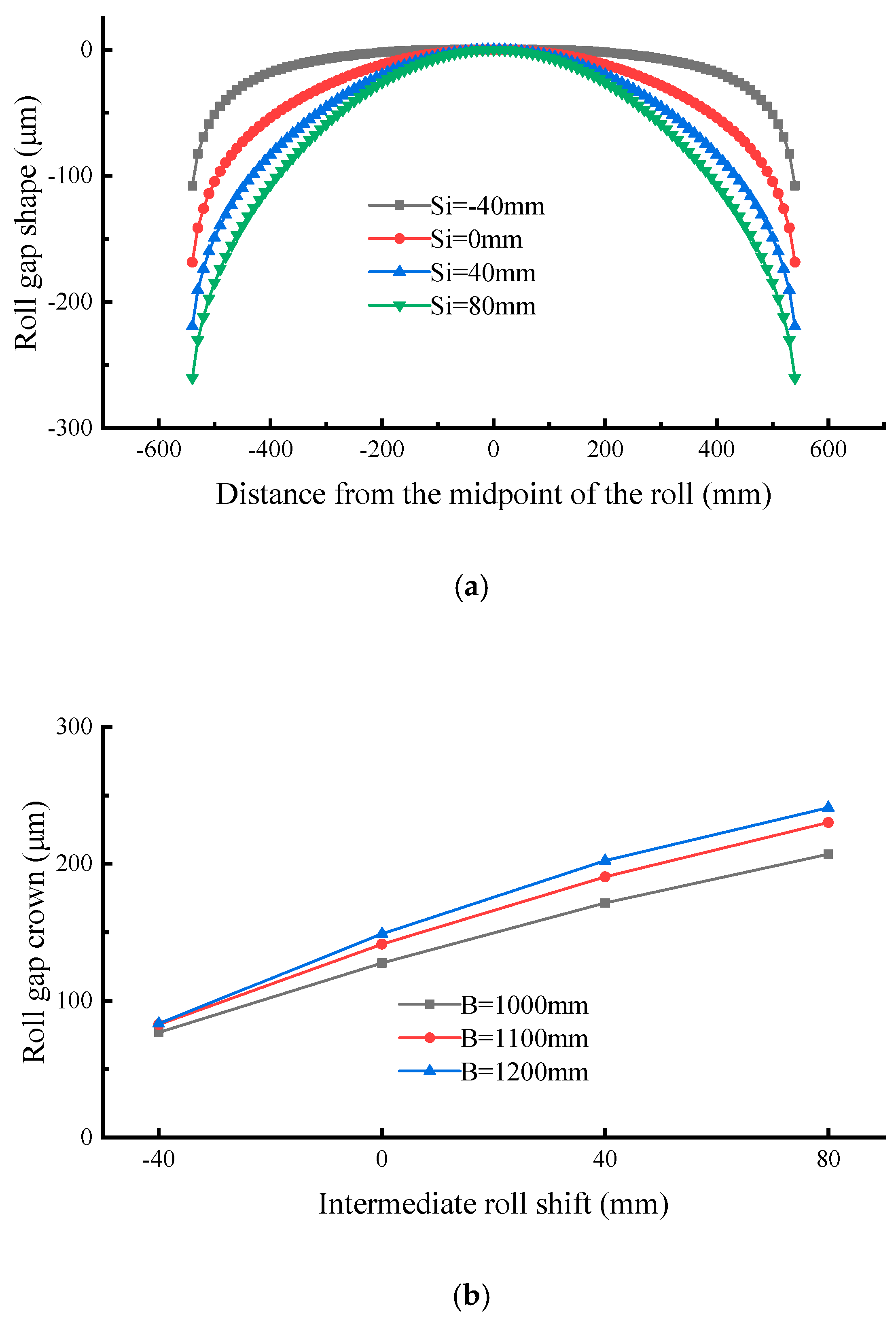
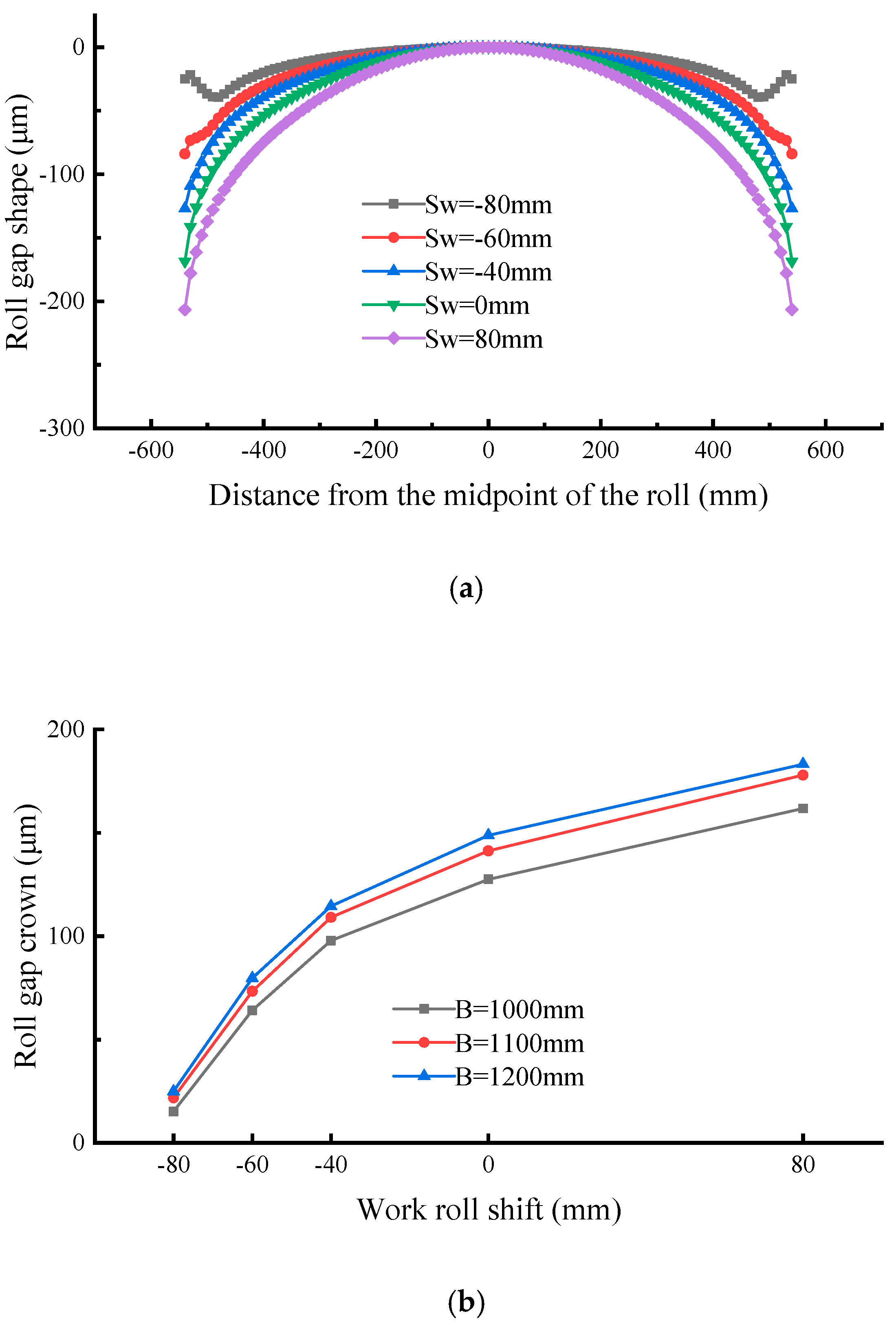
| Roll | Roll Neck (Diameter/mm × Length/mm) | Roll Body (Diameter/mm × Length/mm) |
|---|---|---|
| Backup roll | 770 × 1090 | 1300 × 1420 |
| Intermediate roll | 320 × 975 | 490 × 1500 |
| Work roll | 280 × 1035 | 425 × 1600 |
| Roll Shape | Distance from the Midpoint of the Roll/mm | Radius Difference/mm |
|---|---|---|
| The work roll | 800 | 0.38 |
| 790 | 0.33102 | |
| 780 | 0.28542 | |
| 770 | 0.24320 | |
| 760 | 0.20435 | |
| 750 | 0.16889 | |
| 740 | 0.13680 | |
| 730 | 0.10809 | |
| 720 | 0.08276 | |
| 710 | 0.06080 | |
| 700 | 0.04222 | |
| 690 | 0.02702 | |
| 680 | 0.01520 | |
| 670 | 0.00676 | |
| 660 | 0.00147 | |
| 650 | 0 | |
| The Intermediate roll | −750 | 2.4 |
| −740 | 1.53473 | |
| −730 | 0.86273 | |
| −720 | 0.38326 | |
| −710 | 0.09579 | |
| −700 | 0 |
| Parameters | On-Site Value Range | Simulation Value |
|---|---|---|
| Strip width B/mm | 1000~1200 | 1000, 1100, 1200 |
| Unit width rolling force q/(kN/mm) | - | 6, 9, 12 |
| Intermediate roll bending force Fi/kN | 80~220 | 80, 150, 220 |
| Work roll bending force Fw/kN | 80~220 | 80, 150, 220 |
| Intermediate roll shift Si/mm Work roll shift Sw/mm | 0~80 −80~80 | −40, 0, 40, 80 −80, −60, −40, 0, 40, 80 |
© 2020 by the authors. Licensee MDPI, Basel, Switzerland. This article is an open access article distributed under the terms and conditions of the Creative Commons Attribution (CC BY) license (http://creativecommons.org/licenses/by/4.0/).
Share and Cite
Tao, H.; Li, H.; Shao, J.; Zhang, J.; Liu, Y.; You, X. Research on Shape Control Characteristics of Non-oriented Silicon Steel for UCMW Cold Rolling Mill. Metals 2020, 10, 1066. https://doi.org/10.3390/met10081066
Tao H, Li H, Shao J, Zhang J, Liu Y, You X. Research on Shape Control Characteristics of Non-oriented Silicon Steel for UCMW Cold Rolling Mill. Metals. 2020; 10(8):1066. https://doi.org/10.3390/met10081066
Chicago/Turabian StyleTao, Hao, Hongbo Li, Jian Shao, Jie Zhang, Yujin Liu, and Xuechang You. 2020. "Research on Shape Control Characteristics of Non-oriented Silicon Steel for UCMW Cold Rolling Mill" Metals 10, no. 8: 1066. https://doi.org/10.3390/met10081066
APA StyleTao, H., Li, H., Shao, J., Zhang, J., Liu, Y., & You, X. (2020). Research on Shape Control Characteristics of Non-oriented Silicon Steel for UCMW Cold Rolling Mill. Metals, 10(8), 1066. https://doi.org/10.3390/met10081066





